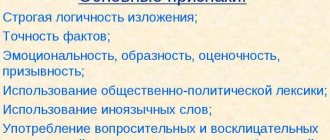In the article you will learn about what a journalistic style is and its main functions, what are the characteristic features and features of a journalistic style of speech, get acquainted with the three genres of journalistic style and at the end of the article you will find interesting information about the criteria by which media news is selected.
Not so long ago, people could only get news from local newspapers, radio and television. Now we have access to any information in any format 24/7 (thank you, Internet!).
Methods of obtaining information have changed, but the principles and features of journalism have remained the same.
What is journalistic style and its main functions
Journalistic style is a style of speech that is used by the media to convey news messages to a mass addressee (newspapers, television, radio, Internet).
The journalistic style performs 2 main functions, and they to some extent contradict each other:
- Informing. The main task of the journalistic style is to inform society about an event that has occurred or events that will occur in the future, while the author of the news report must be as objective as possible.
- Impact on the audience. Some genres of journalistic style are characterized by excessive emotionality with a pronounced position of the author and his personal opinion. Such messages carry social evaluation and appeal, influence the masses and shape public opinion.
Read the articles:
- “Features, characteristics, genres and examples of scientific style of speech.”
- “Features, characteristics, genres and examples of texts of official business style of speech.”
To design presentations, printed materials, publications, create logos, business cards or infographics, I recommend using the Canva program. This is a very simple and convenient all-in-one visual editor. With thousands of professional templates, images, and other quality elements, you'll get a great starting point to bring your best ideas to life.
I. Introduction
Journalistic style is a functional variety in literary language, widely applicable in various fields. This applies more to public life: newspapers and magazines, television and radio, public political speeches. This style is very popular in the activities of both public organizations and individual parties.
We should add to this list political literature and documentary films, intended for both the mass reader and the viewer. Stylistics textbooks define journalistic style as “newspaper”, “newspaper-journalistic” and “socio-political”. [2:7] As for the name “journalistic,” it is more accurate, since other options are a narrower definition of the scope of “work” of this style. The name “newspaper” contains the history of the formation of this style, since the design of its speech features was precisely in newspapers, which were periodicals. Today this style can already be found not only in print media, but also in electronic and television media. The name of the socio-political style more accurately indicates the connection of this style with political and social life. This style is also used in the non-political sphere of communication, in culture, sports, and the activities of various public organizations (human rights, environmental and many others).
The name of the journalistic style shows a close connection with the concept of journalism, which is not linguistic today, but rather literary, since it characterizes certain substantive features of the works that relate to it.
Journalism refers to a type of journalism and literature that examines very current problems in politics, economics, literature, law, and philosophy of today's life. Its goal is to influence not only political institutions, but also the social and political state of society, strengthening or changing them in accordance with moral and social ideals. The subject of any research
The publicist is absolutely the whole life in our time, both public and private. It can be reflected in reality or in the press, documents and art. Journalistic works have their own individual stylistic features.
Journalism plays an important ideological and political role and influences the successful activities of sociological institutes. Through journalism, public education, agitation and propaganda are enhanced; it is a way of transmitting social information to people. Journalism can exist in different forms. These are verbal (written and oral), graphic (posters and caricatures), photo and cinematographic (television and documentaries), theatrical-dramatic and verbal-musical. It is widely used in scientific and artistic works.
Perhaps the most important functions of style are influencing and informational. In addition to them, texts written in a journalistic style also perform other functions that are inherent in language (expressive, communicative and aesthetic).
“Publicism exists in the following forms:
- verbal (written and oral),
- graphically (poster, caricature),
- photo and cinematography (documentaries, television),
- theatrical and dramatic
- verbal and musical." [3:14]
Journalism is often used in artistic and scientific works. The concepts of journalism and journalistic style, as can be seen from these definitions, do not completely coincide. Journalism is a type of literature, and journalistic style is a functional type of language. Works of other styles may differ in their journalistic focus, for example, scientific articles devoted to current economic problems. On the other hand, a text that is journalistic in style may not belong to
to this type of literature due to the purely informational nature or irrelevance of the problems discussed.
Characteristic features of the journalistic style of speech
The journalistic style of speech has a number of specific characteristics by which it is easy to identify:
- Informative title. News headlines are quite long. From the title it is clear what will be discussed next.
- The first sentence (paragraph/lead) briefly summarizes the essence of the news item.
- The "inverted pyramid" principle. The priority, value and usefulness of information decreases from the beginning of the text to its end.
- Sentences and paragraphs are mostly short.
- Lots of specifics and details.
- Readability, simplicity, competent presentation of information.
- Emotionality and evaluativeness.
- Socio-political vocabulary is often used (names of political parties, departments, economic and legal terms, etc.).
- Targeting a mass audience.
- Rhetorical questions, exclamations and repetitions.
- In addition to the basic colloquial (informal) style used in journalism, there are slang and jargon words.
Lexical features
As a rule, journalistic language uses vocabulary characteristic of topics such as medicine, sports, culture, economics, socio-political life and other topics that affect the interests of the audience.
The journalistic style is characterized by orientation and attunement to the viewer or listener, therefore the lexical component of the message will depend on who it is addressed to.
Thus, news on the federal channel, which operates for a wide range of viewers, is presented in a more formal and dry form, while news broadcasts on youth entertainment channels are not only based on informal communication, but also allow the use of jargon and obscene language in some cases .
In addition, journalism uses a number of stable expressions that have emerged recently and remain relevant, as well as loud and apt aphorisms (“stab in the back”, “unprecedented action”).
Often in journalism there is a tendency to express subjective value judgments through characteristic vocabulary (“development”, “flourishing”, “improvement” are examples of expressing approval; “retribution”, “discrimination”, “decline” are examples of expressing a negative attitude towards what is happening).
A description of the journalistic style in terms of its lexical features will not be complete without mentioning emotionally charged linguistic means. The language of journalism should be moderately bright, but at the same time attract sufficient attention. Maintaining this balance is possible by borrowing from the artistic style such means of expression as epithets, metaphors, metonymies, rhetorical questions, irony, phraseological turns, puns, proverbs and much more.
Features of journalistic style
As features of the journalistic style of speech, three key components can be identified, on the basis of which any journalistic text is built:
1. Lead.
This is the first, main or leading paragraph of the text, the “header” or abstract of the article, which sets out the main idea of the text. Often the lead is highlighted in a different font or color and usually takes up 3 to 5 lines of text.
The lead cannot be neglected. It can be sensational or dramatic, it can reveal details of an event or summarize news, it can amuse the reader or challenge him.
A news article lead looks like this:
“The British authorities have officially admitted that they are preparing to abolish the mandatory two-week quarantine for arrivals from several dozen countries, primarily European, as of July 10.”
bbc.com
2. Citation.
90% of all investigative journalism is based on interviews or work with other primary sources. It is therefore not surprising that quotes feature prominently in news reports.
3. Brevity and readability. Sentences and paragraphs are short and simple. This does not mean that you will not find long compound sentences in the text, but in most cases, “brevity is the sister of talent.”
In addition, it is important not to overuse the terms. Still, texts of a journalistic style should be understandable to a mass audience: I used the concept of “legal nihilism” - be kind and then explain what it means (ps: legal nihilism is the denial of laws and rules/norms of behavior).
Morphological features
Morphological features include:
- frequent use of synecdoche - the plural is replaced by the singular or vice versa (fathers, grandfathers, Russian, French
);
- frequent use of imperative verbs (look, think
);
- use of all forms of adjectives (regular, comparative and superlative).
Genres of journalistic style of speech
There are 3 genres of journalistic style:
- Informational (report, interview, note, report). The main function is to communicate information: what, where, when, under what circumstances happened or will happen.
- Analytical (conversation, review, article, review, correspondence). The main function is to influence the public. There are the author's reasoning, argumentation, analysis of the event, personal conclusions and assessment of what is happening.
- Artistic and journalistic (essay, feuilleton, pamphlet, essay). Used to obtain a figurative, emotional idea of an event or fact.
Let's take a closer look at each genre.
Genre originality of journalism
Journalistic works raise quite a lot of topics. Among them are everyday life, philosophy, economics, society, politics, culture, pedagogy and much more. All these questions are addressed in completely different genres, namely:
- informational The works are more reminiscent of documents (notes, reports, reports), and in design they are similar to the official business style;
- analytical. This group of journalistic style includes articles, comments, reviews and reviews. They analyze certain problems. Close to scientific style;
- artistic and journalistic - these are essays, feuilletons, sketches and pamphlets. There are tropes and figures of speech.
Journalistic style of speech: information genre
A note is a short message about a new event or fact. Main features: reliability of fact, novelty, brevity.
Example:
“The amendments to the Constitution of the Russian Federation, which were approved by more than three quarters of the citizens who voted, came into force on Saturday, July 4. The updated text of the country's basic law has already been published by Rossiyskaya Gazeta. 206 amendments have been made to the Constitution. In this regard, it will be necessary to change 98 existing laws.” (Arguments and Facts AIF.ru)
A report is a message from the scene of an event. Features: efficiency, objective coverage of events, the reporter is an eyewitness or participant in what is happening.
Example: television report (live broadcast from the scene), report in print media after collecting and processing information.
Interview - obtaining information during a conversation between the interviewer (journalist) and the interlocutor.
Examples: informational interview to collect up-to-date data about the crash (for example, interviewing eyewitnesses); investigative interview; personal interview or portrait interview.
A report is a chronologically sequential, detailed account of an event. Example: a report on military operations, a report on the results of a meeting, a conference, a government or court meeting.
Journalistic style of speech: analytical genre
Conversation (dialogue) is a type of interview when a journalist acts not just as an intermediary between the hero and the viewer, but communicates with the interlocutor on an equal basis thanks to his achievements, experience and professionalism.
Example: a television show with guest artists - “Alone with Everyone” with Yulia Menshova.
Review is a critical review that contains an assessment and brief analysis of a work of fiction, science, art, journalism, etc.
Example: a book review (examples of reviews are on the Literary Gazette website lgz.ru), a review of a play, movie, TV show, game.
An article is a genre of journalism that expresses the author’s reasoned point of view on social processes, on various current events or phenomena. After reading the analytical article, the reader receives the information he needs and then independently reflects on the questions that interest him.
The subject of the article is not the event, processes or phenomena itself, but the consequences that they cause.
Example: a general research article on the political development of the country, a practical-analytical article on rising food prices, a polemical article (dispute) on teaching the fundamentals of Orthodox culture.
Analytical correspondence is a message that provides information about an event or phenomenon (usually one significant fact). Analytical correspondence may include fragments of a “live” report or a retelling of what is happening, but such a message must include clarification of the causes of the event/phenomenon, determination of its value and significance for society, and prediction of its further development. The primary source of such a message is always the author of the publication (correspondent).
Example: Description of a rather unusual event - the rescue of a person struck by lightning. The main part of the publication is devoted to this event. In describing it, the journalist uses information received from the victim herself, her parents, her rescuers, and other people. The matter is not limited to the description of the event itself. The author carries out a cause-and-effect analysis of what happened, looking for an answer to the questions that torment Dalia Ralene, her parents, and their friends: why did lightning strike this particular woman? Why did she still end up alive?
Journalistic style of speech: artistic and journalistic genre
Essay - a journalist not only describes a problem, event or portrait of a person, based on factual data, but also applies artistic methods of expression.
Example: a portrait sketch about the life of a famous person; description of incidents, meetings with people during the author’s journey (essay by A. S. Pushkin “Travel to Arzrum during the campaign of 1829”).
An essay is a short essay (usually 300-500 words), written in a free narrative style. This is a literary genre in which the author expresses a personal view on a certain problem, his experiences or point of view on some issue.
The essay is written in a free manner with a clearly expressed position of the author, so the text is lively and emotional. The author can write an essay in the 1st or 3rd person (more often).
The essay is characterized by imagery, a conversational style of narration, frankness and targeting a mass audience.
Example: 19th century essayists include Oscar Wilde, Arthur Schopenhauer, Friedrich Wilhelm Nietzsche and many others.
Article “Instructions for writing an essay.”
A feuilleton is a short note, essay, article of a satirical nature, the main task of which is to ridicule “evil.”
Example: feuilletonists include such satirical writers as M.E. Saltykov-Shchedrin, I.A. Ilf and E.P. Petrov.
A pamphlet is a satirical work or article aimed at ridiculing certain human vices, exposing and humiliating a hero or heroes who seem to the author to be the bearer of a dangerous social evil. When writing a pamphlet, the author uses grotesque, hyperbole, irony, and sarcasm.
Example: “Letters to a Provincial” by the French scientist and philosopher Blaise Pascal, “The Grumbled Hive, or Fraudsters Who Became Honest” by the English writer Bernard Mandeville, domestic pamphleteers D.I. Pisarev with the pamphlet “Bees”, A.M. Gorky “City of the Yellow Devil”, L.M. Leonov "Shadow of Barbarossa".
Main features of the style
The journalistic style occupies a special place in the system of literary language styles, since in many cases it reworks texts created within the framework of other styles. Scientific and business speech is focused on the intellectual reflection of reality, and artistic speech is focused on its emotional reflection. Journalism plays a special role - it seeks to satisfy both aesthetic and intellectual needs. French linguist C. Bally wrote that “scientific language is the language of ideas, and artistic speech is the language of feelings.” To this we can add that journalism is the language of both thoughts and feelings. The importance of topics covered by the media requires thorough reflection and appropriate means of logical presentation of thoughts, and the expression of the author's attitude to events is impossible without the use of emotional means of language.
A feature of the journalistic style is its wide coverage of the vocabulary of the literary language: from scientific and technical terms to words of everyday colloquial speech. Sometimes a publicist goes beyond the literary language by using slang words in his speech, however, this should be avoided.
Speaking about the journalistic style, it is necessary to immediately note that not all texts published in the media belong to the journalistic style. For example, the Rossiyskaya Gazeta publishes the texts of laws, decrees, and regulations; they refer to the official business style. Nezavisimaya Gazeta sometimes publishes scientific articles written by specialists; they belong to the scientific style. On the radio they often read novels, novels, stories - these works belong to artistic speech. All this characterizes not the journalistic style, but the social functions of mass media.
The situation is different when a journalist in a newspaper article talks about scientific research on genetics and uses scientific terms, or reports about the launch of a spacecraft, rescue exercises and includes technical terms in his speech, and uses legal vocabulary in a judicial chronicle. In these cases, other-style elements (words and figures of speech) are included in the expressive means of the journalistic style and are included in the language of the mass media. It is these cases that are meant when linguists talk about the interaction of different style units within the framework of newspaper and journalistic style. This interaction is also an important feature of the journalistic style.
It is enough to open any issue of any newspaper and look at its headlines to be convinced of the thematic vastness and breadth of journalism. You will receive a kind of summary, a snapshot of the contents of the newspaper. A newspaper can write about politics, diplomacy, sports, art, social movements, economics. The topics of newspaper publications are so varied that it is difficult to exhaust them.
So, the journalistic style, one of the varieties of which is newspaper speech (newspaper substyle), turns out to be a very complex phenomenon due to the heterogeneity of its tasks and communication conditions. We will talk first of all about the features of newspaper speech, since it has been more studied in modern style. The term “journalistic style” is used deliberately for the sake of preserving the unity of terminology (common names of functional styles).
One of the important functions of journalism (in particular its newspaper and magazine variety) is informational. The desire to report the latest news as soon as possible could not but be reflected in the nature of communicative tasks and in their speech embodiment. However, this historically original function of the newspaper was gradually pushed aside by another - agitation, propaganda or influence. “Pure” information content remained only in some genres, and even there, thanks to the selection of the facts themselves and the nature of their presentation, it turned out to be subordinate to the main, namely agitation and propaganda, function. Because of this, journalism, especially newspaper journalism, was characterized by a clearly and directly expressed function of influence, or expressiveness. These two main functions are not separated in newspaper speech today.
The genre repertoire of modern journalism is also diverse: reportage, notes, chronicles, interviews, editorials, reports, essays, feuilletons, reviews, and other genres.
Journalism is also rich in expressive resources. Like fiction, it has significant power of influence, uses a wide variety of tropes, rhetorical figures, and a variety of lexical and grammatical means.
The presence of a standard is another main stylistic feature of journalistic speech.
It should be taken into account that the newspaper is distinguished by a significant uniqueness of the conditions for linguistic creativity: it is created in the shortest possible time, sometimes not allowing the opportunity to bring the processing of linguistic material to the ideal. At the same time, it is created not by one person, but by many correspondents who often prepare their materials in isolation from one another.
The main stylistic principle of V.G.’s journalism Kostomarov defines it as unity, the combination of expression and standard, which constitutes the specificity of newspaper speech. Of course, in a certain sense, the combination of expression and standard (in certain “doses”) is characteristic of all speech in general. However, it is important that it is in newspaper journalism, unlike other speech varieties, that this unity becomes a stylistic principle for organizing a statement. This is the main meaning and, undoubtedly, the value of V.G.’s concept. Kostomarova. Meanwhile, the first component still has priority in this unity.
The style of journalistic, especially newspaper, speech is strongly influenced by the mass nature of communication. A newspaper is one of the most typical media and propaganda. Here both the addressee and the author are massive. Actually, the newspaper and a specific correspondent, as a rule, express the position of millions of like-minded people. In this regard, one of the characteristic stylistic features of journalistic, especially newspaper, speech is a kind of collectiveness, expressed in the particular meanings and functioning of linguistic units. Collectivity as a linguistic feature of newspaper style is embodied in the uniqueness of the category of person (the use of the 1st and 3rd person in a generalized sense), and in the relatively increased frequency of the pronouns we, you, our, your and in the peculiarities of their use.
The other side of the above-mentioned style-forming unity - the information function - is embodied in such features of the journalistic style that are associated with the manifestation of the intellectuality of speech. These style features are:
- documentaryism, manifested in objectivity and verified factuality of presentation, which in stylistic terms can be defined as emphasized documentary and factual accuracy of expression; documentary and factual accuracy is manifested in the terminology of speech, the limited metaphorization of terms (except for the generally accepted one), and the widespread use of professionalisms;
- restraint, formality, emphasizing the importance of facts and information; these features are realized in the nominal character of speech, the originality of phraseology (clichés), etc.;
- a certain generality, abstraction and conceptuality of presentation as a result of analyticity and factuality (often in unity with figurative concreteness of expression).
This is the complex stylistic structure of newspaper speech.
The newspaper is also characterized by the search for biting and accurate assessments that require unusual lexical combinations, especially during polemics: a giant trust of deception; suspected of loving freedom.
Expression of assessment is expressed by superlative forms in the elitative meaning: the most decisive (measures), the most severe (crisis), the most acute (contradictions); most excellent, strictest, most advantageous.
These are, in general terms, the main features of newspaper style and the linguistic means of their implementation.
The material for creating evaluative newspaper and journalistic vocabulary is the entire dictionary of the literary language, although some of its categories are especially productive in journalism.
The influencing function of the newspaper-journalistic style is especially clearly manifested in syntax. From a diverse syntactic repertoire, journalism selects constructions that have significant potential for impact. It is expressiveness that attracts journalism to the constructions of colloquial speech. They are, as a rule, compressed, capacious, and laconic. Another important quality is their mass character, democracy, and accessibility. Against the background of the generally bookish syntax of journalism, colloquial constructions stand out for their stylistic novelty.
Chopped prose, which comes from colloquial speech, is also characteristic of many journalistic genres: short, abrupt sentences, reminiscent of painterly strokes that make up the overall picture:
Palm trees, sand, water. Coast of Ceylon. The pointed leaves of coconut palms move and rustle in the wind. The sand is wet and heavy from the tidal wave. The sun will dry them at low tide. In the meantime, water is the sovereign mistress. Villages cling to the ocean. Huts made of palm leaves, bamboo, coated with clay, protected from the sun by the leaves of coconut palms.
The newspaper-journalistic style is also characterized by its system of genres. Each genre is a certain way of organizing speech, a certain speech form in which the main role is played by the image of the author.
The newspaper-journalistic style is characterized by a fundamental coincidence of the author and the narrator. This coincidence is the main difference between journalistic speech - its “openness,” documentary, emotionality. The publicist directly and directly addresses the reader with his thoughts, feelings, and assessments. And this is the strength and expressiveness of journalism.
News selection criteria
First of all, the journalistic style is associated with journalism and the media. News items occupy a special place in the media: they are in demand and attract the bulk of traffic. Therefore, I propose to pay attention to one very interesting point: how is a news message created and by what criteria are news “selected”?
Below you will learn about 10 criteria for selecting news:
- Relevance . The news must correspond to the needs and interests of the audience. Residents of Kyiv are not particularly useful information about the construction of a new road in the town of Mironovka.
- Timeliness . Information about the event must be fresh and appear on time; no one will read about the voting results two weeks after the elections.
- Clarity and unambiguity. Simple, understandable news is more accessible to the general public and generates more interest.
- Predictability . Significant events usually have specific dates (for example, election day, the start of the Olympic Games, the date of the football championship). Therefore, as such an event approaches, public interest increases and the news becomes more valuable.
- Surprise . On the other hand, unpredictable events and phenomena (natural disasters, catastrophes or crimes) also arouse public interest.
- Significance and scale of the event . War, elections, protests, sports games and other important events require lengthy and detailed press coverage.
- Composition . Sometimes, in order to dilute, for example, the negativity of the information flow, the editor selects news items of an opposite nature: funny incidents, love, romance, rescue, animals, adventure, risk, etc.
- Celebrities . Due to their status and recognition, news items with the participation of politicians, artists, and athletes are more often published in the media and arouse increased interest.
- Countries that occupy a leading position in the world economy and politics. A strike, natural disaster or plane crash in a developed country will immediately hit the media, but you can write about the lack of drinking water in Ethiopia later.
- Negativity . “Bad” news is more popular.
PS: Did you like the article? Share the link on social networks! Thank you very much and have a nice day.
Sources:
- A. A. Tertychny “Genres of periodical press: textbook”;
- Media ethics owl.purdue.edu
- Robert M. Knight "Journalistic Writing: Building the Skills, Honing the Craft"
Syntactic features
The syntax of the journalistic style is structured in such a way as to attract the attention of the audience and, in some cases, induce it to take certain actions. The syntactic features of the journalistic style are as follows:
- Rhetorical questions are used to show the obvious evidence of the answer to the question posed. In this case, there is a feeling of complete agreement between the public and the informant (Are we really going to tolerate this?).
- Often an informant in journalism turns to a question-and-answer form of presentation, which allows him to enliven the dialogue and avoid monotonous and dry transmission of information (What to do in this case? First, you need to contact the police).
- To enhance the effect produced or to place emphasis in a statement, repetitions are often used (He could create and create like no one else).
- Exclamatory sentences work as a call to action or create an atmosphere of solemnity (Cheer up! Happy New Year!).
- To create a special connection between the informant and the public, addresses are used (Gentlemen, comrades, Russians, etc.).
- Inversion helps to place emphasis in the message so as to convey information in descending order from the most important to the details (All the crew members of the crashed plane survived, etc.).
- Journalism often turns to such a technique as parcellation (dividing a sentence) to create a special effect (We all want to live well. Have a great job. Family. Be worthy people.).
Lexical, morphological and syntactic features of the journalistic style work together to create a unique language of journalism that attracts millions and billions of readers and listeners. To understand what a journalistic style is, it is enough to analyze a newspaper article or news report, noticing the subtleties and features of this language.









